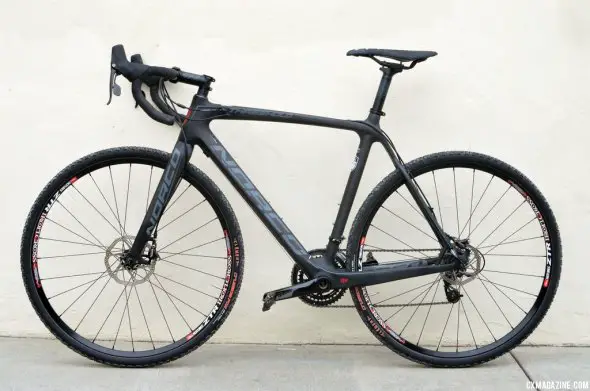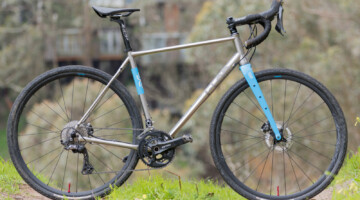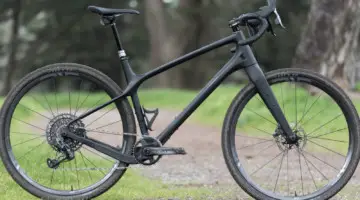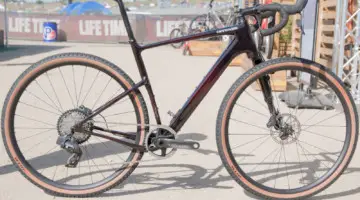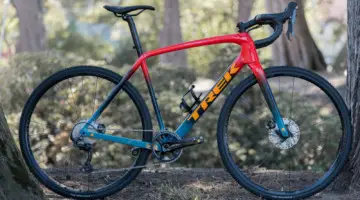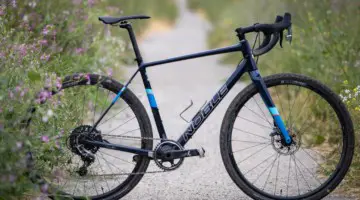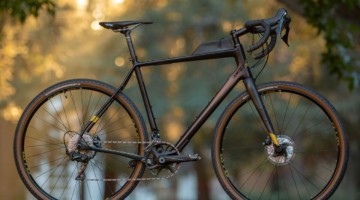Norco is one of the biggest performance bicycle companies in Canada, and even though Canada is our closest neighbor, the brand is still relatively small in the U.S., flying under the radar of many bike buyers. That said, their large size allows Norco the resources to spec and deliver a carbon ’cross bike with hydraulic brakes for $4000. That’s not cheap, but not over-the-top for a ready-to-race carbon rig with some of the latest technology included. Is it worth the cost? We put it through the paces to find out.
If looks could make a bike fast, this bike would break the ’cross course lap record every time. Like the Foundry Harrow we also reviewed in this issue, it’s matte black finish with bold tube shapes melded together and sublimated graphics give the bike a look that’s all business.
The Frame
The all-carbon monocoque frame is literally labelled with Norco design technologies: “Armor Lite/Power Chassis/Norco carbon tubing/smooth seatstay” design. This bike is designed by Norco from the ground up and manufactured by a partner in Asia. The Armor Lite refers to Norco’s resin formulation that they claim to produces better bonding of the carbon fibers and offers better impact resistance. The Norco Power Chassis design is obvious when you look at the stout diamond-shaped down tube blending into the absolutely massive bottom bracket area, allowing for the large diameter BB30, and then exiting to the large section chainstays. The idea here is complete energy transfer from frame integration of the steering components to the rear wheel. Despite the massiveness of the chainstays, there still appears to be enough room to squeeze a 35mm tire in there. Finally, the “smooth seatstay design” is a wishbone-style arrangement that is 4.5cm wide but only 1.5cm thick, theoretically allowing some flex in the vertical plane, while maintaining stiffness in the horizontal plane.
The top tube has flat top with a curved, nicely radiused bottom side. The rear brake hose runs internally through the top tube and exits in front of the seatpost, then runs externally along the back of the seatstay. If you decide to use a mechanical disc brake, a full length of cable housing is required. The gear cables run internally as well, but they include cable stops at the entrance and exit from the frame tubes, allowing the cables to run without housing internally, saving some weight. Curiously, the front derailleur cable runs along the down tube and enters the underside of the bottom bracket, exiting at the top at an angle that puts the cable path into the derailleur body instead of the arm, a minor nuisance in set up, but not in function.
The frame geometry reveals no surprises with a 6.5cm bottom bracket drop, 42.5cm chainstays, a slightly short 55cm effective top tube on our 56cm frame and a combination 72.3/73.5-degree head tube/seat tube angle lab-verified from the spec sheet.
The cantilever brake-equipped version does not exist any longer and with that, gone are the replaceable dropouts that allowed track ends for singlespeed use. The dropout design had to change with the need to position the disc brake post mounts and have the wheel positioned consistently for proper rotor placement. The left rear seatstay and dropout has post mounts for the brake caliper and a short truss braces the seatstay to the chainstay, a design that gives the most stiffness possible to this mounting point.
Norco completes the frame with an all-carbon tapered-steerer fork with post-mounts for the disc brake caliper as well as fender eyelets. The fork ends have retention tabs for a standard quick release wheel.
The Build
The Threshold C1 comes equipped with SRAM S-700 hydraulic disc brakes with Rival derailleurs and an S-Series crankset. The bike is set up for a 140mm rear rotor, while the fork has post mounts for a 160mm rotor. It comes with Stan’s NoTubes Iron Cross rims laced to SRAM X9 hubs, laced cross-two with 32 double butted spokes, along with an Easton EA70 bar and stem and Fizik Tundra 2 flat saddle. The saddle is well-padded, and though I like a saddle with some curve, I found this to be comfortable. Norco-branded rubberized padded tape is a nice grippy additon.
Complete weight with Clement PDX tires and tubes and no pedals was 18.84 pounds; without wheels, it weighs 11.5 pounds. That seems a bit heavy for a $4000 bike, but it’s mostly due to the crank and Rival derailleurs, though additional weight can be pared down via a swap to carbon race wheels. That said, I don’t consider the Iron Cross to be a heavy clincher set, especially when run tubeless, though our sample had tubes.
The top model, the Threshold Carbon SL, is SRAM 22 with hydraulic disc brakes, with Easton EA90 tubeless wheels with 140mm discs front and rear, while the lower model, the C2 comes Shimano 105, Hayes CX5 mechanical disc brakes and Alex wheels, all utilizing the same frame.
Our biggest gripe is that Norco opted to pair a non-Yaw Rival front derailleur with S-700 shifters which are designed for a Yaw front derailleur, eliminating the need for shifter trim. The result? Noisy, annoying chain rub.
The Ride
I already mentioned that the bike could be lighter, and that aspect holds back its full potential in this review. That is mostly noticed when lifting the bike, and though 19 pounds is not even close to “heavy,” I think my subconscious expectation that a carbon bike should be super-light plays a big role in this perception.
Regardless, weight is only one small aspect to a bike’s ride qualities. As a race bike, this bike shines in its stiffness. When you push on the pedals, the bike does not seem to bend at all—try thrashing the bike in a sprint, or coming up a ride-up in a gear that is a bit too high and the bike will keep its line and go where you push it. The same is true through a smooth chicane, making for great fun flowing through a forest on smooth single track or around a tight ’cross course. When the track gets bumpy, much like other stiff bikes, the Norco Threshold transmits a lot of the terrain to the rider, and as in other reviews, tire and tire pressure choices will play a big role in ride comf
To read the rest of the review, get your hands on a copy of Issue 23 of Cyclocross Magazine!
You can get a back copy of Issue 23 here, but if you can’t wait, there are plenty of digital options. Download our app from iTunes (here for the iPad version and here for the iPhone version) and subscribe for access to all the cyclocross content you can handle, or browse the Apple Newsstand to see what the latest issue holds.
For those Android-users out there, we have you covered with our app available in the Google Play store, so you’ll never have to glance longingly at your buddy’s iPad as he reads an interview with Jonathan Page or Lars van der Haar to get psyched up for a race.
And for those of you who want to read the magazine on your computer, your Kindle, or most other places, there’s Uberflip. Not only is it a cross-platform way to subscribe, Uberflip boasts (in addition to a standard subscription) our All Access Digital Pass, which allows you to read every single back issue of Cyclocross Magazine, so you can see how far we—and the sport—have come over the past few years.
Vital Stats:
- MSRP: $3999 (CAD)
- More Info: Norco.com
Clifford Lee
Latest posts by Clifford Lee (see all)
- Bianchi Zolder Pro Cyclocross Race Bike Ridden and Reviewed - November 30, 2025
- Ridden and Reviewed Kona Libre CR - September 11, 2025
- A Bucket List Day at the Sven Nys Cycling Center in Flanders - August 13, 2025













